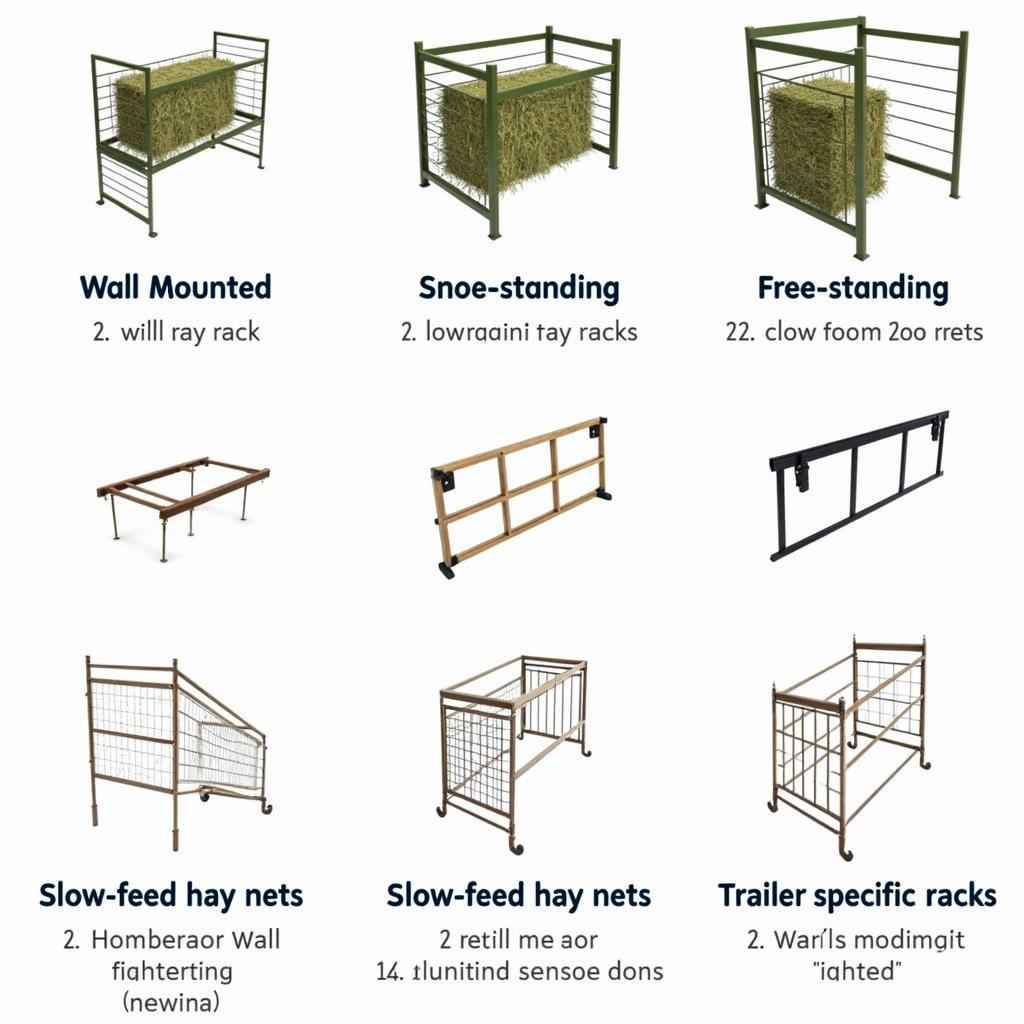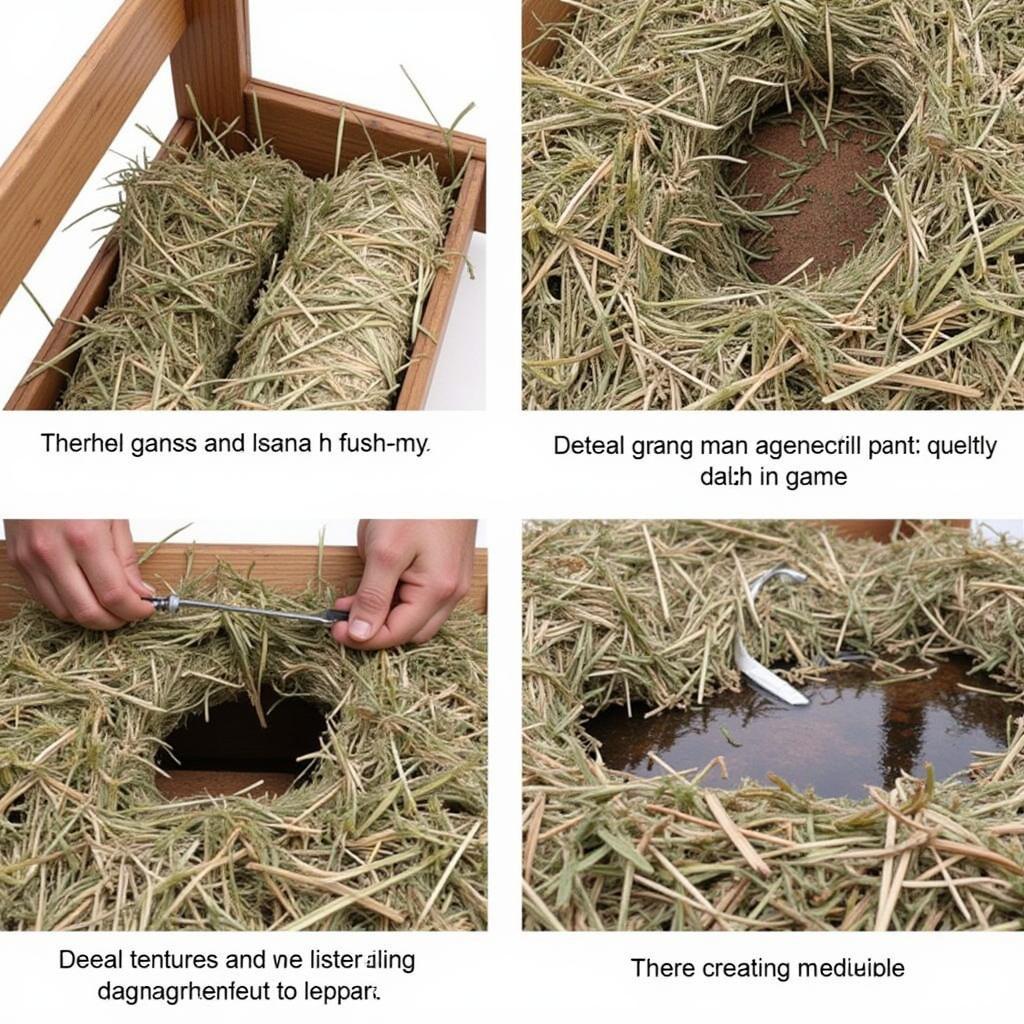Hay racks are an essential part of horse ownership, ensuring your equine companions receive their vital forage in a safe, efficient, and healthy manner. Choosing the right hay rack can significantly impact your horse’s well-being, minimizing hay waste, reducing the risk of respiratory issues, and promoting natural grazing behavior. This guide explores the world of Hay Racks For Horses, providing you with the information you need to make an informed decision for your barn.
Choosing the right hay rack is about more than just convenience; it directly impacts your horse’s health and your wallet. A good hay rack minimizes waste, preventing your horse from trampling and soiling valuable hay. It also encourages slower consumption, mimicking natural grazing patterns and reducing the risk of digestive upset. Plus, by keeping hay off the ground, it helps prevent respiratory problems caused by dust and mold.
One key factor to consider is the material. Hay racks come in various materials, including metal, wood, and plastic. Each has its pros and cons. Metal hay racks are durable and easy to clean, but can be more expensive. Wooden racks are a more natural-looking option, but require more maintenance. Plastic racks are lightweight and affordable, but may not be as durable as metal or wood. Thinking about horse hay rings can also be a good alternative.
Different Types of Hay Racks for Horses
Understanding the different types of hay racks available will help you choose the best one for your specific needs. From wall-mounted racks to free-standing models, the options are plentiful. Wall-mounted hay racks are a great space-saving solution, particularly for smaller barns. They keep hay off the floor and can be installed at a comfortable height for your horse. Free-standing hay racks offer more flexibility in placement and are often larger, accommodating more hay. There are also slow feed hay nets, which are designed to prolong feeding time and encourage more natural grazing habits. Looking at some horse hay feeder ideas can broaden your horizons.
Another type to consider is the hay rack designed for horse trailers. These are typically smaller and designed for secure transport. Check out our resource on hay racks for horse trailers for more specific information.
 Different Types of Hay Racks for Your Horses
Different Types of Hay Racks for Your Horses
Sizing and Placement of Hay Racks
The size of your hay rack should correspond to the size and number of horses using it. A single horse will need a smaller rack than a group of horses. Placement is equally important. Ensure the rack is positioned at a comfortable height for your horse to eat without straining its neck or back. Avoid placing hay racks near water sources to prevent contamination. Providing enough space around the hay rack allows for comfortable and safe access for all horses.
How High Should a Hay Rack Be?
Ideally, the bottom of the hay rack should be level with the horse’s point of shoulder or slightly below. This allows the horse to eat in a natural position, mimicking grazing.
Maintaining Your Hay Rack
Regular maintenance is crucial for the longevity and safety of your hay rack. Inspect your hay rack regularly for any signs of damage, such as sharp edges or broken parts. Clean your hay rack regularly to remove any leftover hay, dust, and debris. This prevents mold and bacteria growth, protecting your horse’s respiratory health. For metal racks, check for rust and treat accordingly. Wooden racks may require occasional repainting or sealing to protect against weather damage.
Choosing the Right Hay Rack: Key Considerations
Several factors influence the best hay rack choice. Consider your horse’s size, age, and any specific dietary needs. The number of horses you have and the layout of your barn will also play a role. Think about your budget and the level of maintenance you’re willing to undertake. Finally, prioritize safety and choose a hay rack that minimizes the risk of injury to your horses. Consider also their water needs and the right water container for horses.
“Investing in a quality hay rack is an investment in your horse’s health,” says Dr. Emily Carter, DVM. “It’s a simple way to promote good digestion, minimize waste, and prevent respiratory issues.”
 Keeping Your Hay Rack Clean
Keeping Your Hay Rack Clean
Conclusion
Selecting the right hay racks for horses is a crucial aspect of responsible horse ownership. By carefully considering the various factors discussed, such as material, type, size, placement, and maintenance, you can ensure your horses receive their forage in a manner that promotes their health and well-being. A well-chosen hay rack will minimize waste, encourage healthy eating habits, and contribute to a cleaner, safer barn environment. For healthier hooves, you might also consider looking at hoof supplements for horses.
FAQ
- What is the best material for a hay rack?
- How do I choose the right size hay rack for my horse?
- Where should I place a hay rack in my barn?
- How often should I clean my hay rack?
- What are the benefits of using a slow feed hay net?
- Can I use a hay rack in my horse trailer?
- How do I prevent my horse from wasting hay?
Common Hay Rack Scenarios and Questions
Scenario: Multiple horses fighting over a single hay rack.
Solution: Consider adding more hay racks or using a larger rack to accommodate all horses comfortably.
Question: My horse is pulling hay out of the rack and wasting it.
Solution: Try using a slow feed hay net or a hay rack with smaller openings to slow down consumption.
Further Resources
For more information on horse care and equipment, browse our website for related articles.
If you need further assistance, please contact us:
Phone Number: 0772127271
Email: [email protected]
Address: QGM2+WX2, Vị Trung, Vị Thuỷ, Hậu Giang, Việt Nam.
We have a 24/7 customer service team.